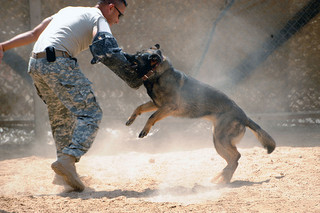 A major part of my background is guard dog training. When I was a goofy teenager (as opposed to the goofy adult that I currently am) working for a dog trainer I was introduced to just how cool guard dog training can be. Following that job I worked for several years at one of the country’s premiere protection and guard dog companies in the world.
A major part of my background is guard dog training. When I was a goofy teenager (as opposed to the goofy adult that I currently am) working for a dog trainer I was introduced to just how cool guard dog training can be. Following that job I worked for several years at one of the country’s premiere protection and guard dog companies in the world.
My adventures in this arena have taken me around the world. I’ve worked with clients in half a dozen countries and about half of the United States in helping them with their guard dog and protection dog needs.
This style of training is fun. It’s interesting. It’s unique.
Don’t even think about trying to do it unless you are working with a professional.
Having said that, allow me to present some more info on guard dog training:
Guard Dog Breeds
There are several breeds that are most often used for protection training. The most common would be the Belgian Malinois, German Shepherd, Rottweiler, and Doberman. Outside of those breeds its not uncommon to find the Pit Bull, Dutch Shepherd, Cane Corso, Presa Canario, American Bulldog, Bandog, Beauceron, amongst others.
The question often posed is, why are these breeds used more than others. The simple answer is that these breeds have been bred to have certain qualities that make guard dog training possible. Just as you aren’t going to use a Doberman for hunting ducks you also aren’t going to use a Labrador for guard dog training. The capacity just isn’t there based on traits that each dog was bred for.
Foundation Training
It is critical to have the highest levels of obedience training if you are going to protection train your dog. It is irresponsible and a liability to train a dog to bite, defend, attack, or protect on command if you don’t also have complete verbal control over your dog at all times.
This means that your dog, both on and off leash, will respond to your commands even under heavy distraction. Anything less is setting yourself and your dog up for problems.
Maintenance Training
Training a guard dog isn’t a ‘set it and forget it’ type thing. You’ll want to maintain your dog’s skills throughout his or her life. Ideally you can set up surprise scenarios where you call on your dog to protect you when your dog is least expecting it.
Guard Dog Gender
Both males and females can excel at guard dog training. Males tend to be larger, stronger, and more athletic. Females tend to be more nurturing and intuitive. Having said that, there are exceptions to these rules.
The most critical thing with guard dog training is that you employ a professional trainer who knows how to best mold your dog into the guard dog that you want him or her to be. A good guard dog should be part protector and part family pet and only a professional can help you achieve that.
Image credit: DVIDSHUB








7 Responses to “Guard Dog Training”
We have a Cane Corso. We live in Italy because we are a army family. She is 7 months old and is 80 lbs. She is very obedient and is cautious a bout people but loves people. She can run about 20 mph and is very athletic. We want her to not only chase bikers and small cars (We have a fenced in yard) but know when to attack. She was the runt but best of the mix. She is supposed to be a bout 100lbs. How do we train her to guard but love people.
p.s she knows lay down, speak, sit, paw, fetch, and °go get them.°
You can’t train a dog to be a guard dog on your own. You’re going to need to find a professional that can help you. A novice who undertakes a task like that is asking for trouble. Find a pro to help you where you’re living.
I have a one year old akita/cane corso mix. She didn’t require any training to be not only an amazing family dog to my husband and 2 month old son, but also a guard dog. We started her in puppy training classes as soon as we got her and took her for many walks to socialize her some. After the simple commands of sit, stay, etc. were established she picked up on friend and foe. Your dog will naturally fall into the breed they are and guard you and your home. I was told these breeds don’t need training for this because they are natural guarders.
I’m getting a dog in about 2 weeks and I want to train him to be a watch dog so when someone comes to the door the dog would bark and let me know there was someone at the door because sometimes I can’t here the door bell in certain rooms in my house.
P.S I live in NY.
I just came across your blog and wanted to
drop you a note telling you how impressed I was with
the information you have posted here.
If you have a moment, please visit my site:
It covers Pet Transportation related subjects.
I send you warm regards and wish you continued success.
The best dogs for personal protection training are German Shepherds since they can understand when there is a need to cut off aggression and when to show it. This breed of personal protection dogs has a natural instinct of protecting its owner.
Welcome to our country of Costa Rica. It is a wonderful place and we need you.
I have a 16 week old GSD who I have been working with for the past eight weeks. Since I am retired he and I have the time to broaden his training and experience. He is well-socialized but already alert to strange situations. He is coming along quite nicely. If you are still in Costa Rica, I would like to learn more of your training methods. I am enjoy good health and I am active but the day will come when I or ,u mother-in-law will possibly need a service dog. We live in Cartago but once my wife (a tica) retires we will move to a remote location on the Nicoya Peninsula in Puntarenas.
Is it possible to evaluate Rico at his age? I look forward to your response.
Are you conducting classes here? If so, where and when.